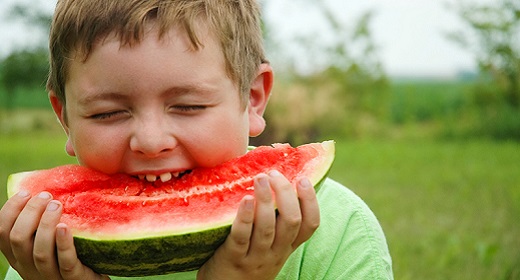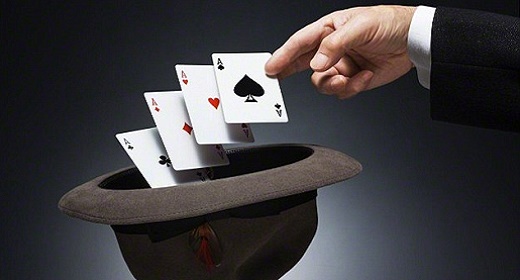by Brian Handwerk: Human noses are especially attuned to picking up odors in bananas, urine and human blood…

In 2007, some UC Berkeley neuroscientists decided to work their students like dogs.
They dipped twine in chocolate essence, zigzagged it across a grassy field, and instructed human volunteers to track the scent as if they were bloodhounds. To ensure that they were only relying on their sense of smell, the researchers had their subjects get down on all fours while blindfolded, ear-muffed and wearing thick knee pads and gloves.
The verdict: While not quite as effective as hounds, humans can follow a scent trail. And they get a lot better at it if they keep trying.
“They showed that humans could do it,” says Joel Mainland, a neuroscientist at Philadelphia’s Monell Center who helped lay the groundwork for the scent-tracking study. “They were much worse at it than dogs, but if you let them practice for a few weeks, they also got much better very rapidly.”
Yet in the decade since, the idea that humans are prodigious sniffers hasn’t really caught on. We tend to get overshadowed by other animals like dogs, which are so reputed for their olfactory abilities that we employ them to tease apart the chemical vapors from bombs, drugs and even cancer on our behalf. And how could we hope to compete with blind moles that smell in stereo, pigs that hunt down underground truffles or honeybees that seek sweetness with their delicate antennae?
John McGann, a sensory neuroscientist at Rutgers University, believes that we humans aren’t giving ourselves enough credit. “Most of us think that our sense of smell is terrible, and it’s not,” he says. “It’s really quite good.” Even better, he has the evidence to prove it.
In a recent review article in Science, McGann argues that we’ve actually outperformed super-sniffers like dogs at certain smelling tasks, and are better at detecting particular aromas that might be important to us. He also explains exactly how he believes we first convinced ourselves that our sense of smell, well, stinks. According to McGann, our olfactory inferiority is nothing but a 150-year-old myth born of erroneous assumptions and faulty science.
Origins of Olfactory Inferiority
The story begins in the brain—specifically the olfactory bulb, the brain’s smell-processing center. Located in the forebrain, this bulb is directly connected to the olfactory receptor neurons that line the inside the nose. These receptors collect information from airborne scent molecules and transmit them up to the brain via the olfactory tract.
In the 19th century, neuroanatomist Paul Broca was searching for what he believed made humans special: free will. He didn’t find a free will center, but he did find that the large frontal lobes that enabled complex cognition and language in humans were absent in species with smaller frontal lobes. Bigger must be better, he surmised. Therefore, Broca deduced that humans’ olfactory bulbs—which are small relative to our total brain size—would enable a far weaker sense of smell than the relatively larger ones found in other animals.
That theory lacked any analysis of humans’ actual olfactory abilities, McGann notes now. But at the time, it stuck: Researchers began to believe that, as humans evolved, the primitive smelling ability of “lower” animals gave way to advanced cognition in the human brain, based on the relative sizes of these regions. Philosophers and psychologists also relied on this assumption; even Sigmund Freud wrote of childhoods centered on smell or taste that were “harking back to early animal forms of life.”
In fact, McGann writes, studies have found little evidence to suggest that olfactory bulb size predicts smelling ability. Bigger animals might need larger brains to control more muscles or process more sensory information, he explains. “However, a larger animal would probably not have more odors it needed to detect and interpret just because it was bigger, so maybe it wouldn’t necessarily need a larger olfactory center.”
McGann speculates that bulb size may not matter whether considered relative to overall brain size or in absolute terms. The human olfactory bulb, which is five to six millimeters in width and only one-third the volume of a dog’s, may be plenty big enough to get the job done. After all, it’s much larger than the same bulb in a mouse or rat, two animals that are considered to be strong smellers.
Adding to the intrigue is the fact that the number of neurons found in those olfactory bulbs is remarkably consistent across mammals, McGann reports. Among a group of mammals with an 5800-fold range in body weight—from the tiny mouse to a male human—the number of olfactory bulb neurons changes by only 28-fold. Human females, interestingly, have more neurons than a mouse or hamster but less than a macaque monkey. (Human males have slightly fewer.)
“The idea they are consistent across all those animals suggests something about coding and processing odors is also constant across animals,” says Mainland, who wasn’t involved in McGann’s work. “I still don’t have a theory about why that would be given that each animal does have a different number of receptors and has very different behavioral tasks that it’s trying to solve. It’s not clear what it means, but it’s fascinating that it’s true.”
How Does the Human Nose Compare?
Matthias Laska, a zoologist at Sweden’s Linköping University, has authored numerous studies comparing the olfactory abilities of humans and other animals. “For 100 years the textbooks have promoted this over-generalization that humans would have a poor sense of smell while animals would have a better one,” he says. “The hard data that would support such a black and white difference simply don’t exist. I don’t want to imply that humans would have a sense of smell that’s as good as a dog in general, but there are certain substances to which we are clearly more sensitive.”
Scents that humans are particularly attuned to include chemical components in bananas, flowers, blood and sometimes pee. In 2013, Laska and colleagues tested the abilities of humans, mice and spider monkeys to detect urine odors found in common mouse predators. While mice were best at detecting 4 of 6 distinct odors humans were actually more sensitive the other two. Humans have also been found as able as dogs and rabbits at smelling the main odorant in bananas (amyl acetate), and are more sensitive to mice than at least one component odor of human blood.
These single smell studies are merely snapshots. But they suggest something tantalizing: that different species specialize in different scents that are important to their lifestyles or ecological niches. Mice, naturally, should be especially good at sniffing out their particular predators, while humans have a nose for knowing when they are injured and bleeding.
For example, Laska notes, the total number of odorants for which dogs have an established, lowest detectable threshold level is 15. Humans actually have a lower threshold for five of those. “Those five odorants are components of fruit or flower odors,” he says. “For a carnivore like a dog those odorants are behaviorally not as relevant, so there was no evolutionary pressure to make a dog’s nose extremely sensitive to fruit and flower odors.”
On the other hand, nine of those 10 odorants for which dogs are clearly more sensitive than humans are carbolic acids. Those components are found in the body odors of likely dog prey, he adds, suggesting one reason why dogs might have become good at tracking them down.
Detecting specific odors is only the beginning. When it comes to scent, behavior may play as big a role as physiology, adds Alexandra Horowitz, who runs a dog cognition lab at Barnard College and is the author of Inside of a Dog: What Dogs See, Smell, and Know.
“Dogs bother to sniff at all,” Horowitz points out. “They put their noses to things … Behavior alone indicates that we are not smelling. Look to what we do with smell: find the Cinnabon store at the airport, versus what dogs do. Dogs can recognize us by scent, find the smell of a missing person in his footsteps left days before, and detect a trillionth of a gram of TNT.”
Besides having more olfactory receptor cells than humans, dogs also boast a specialized snout adapted to methods of breathing that deliver a steadier stream of information-rich scent. Dogs and some other animals even experience scent differently. Their olfactory system allows them to smell liquid phase chemicals that aren’t airborne—think of layers of urine and other liquids on your neighborhood fire hydrant—by working like a pump to deliver them to a specialized nasal organ.
Mainland agrees that smell is central to animal behavior in a way that it’s not in our own world. “Think of predator-prey interactions, mating interactions, territory marking. These are all related to smell and in a huge set of species they are the most fundamental behaviors you can imagine. They’re essential to survival,” he says.
But while smell may not play such a dominant role in our own lives, studies have shown that it may be having more subconscious impacts than we often imagine.
“There are a lot behavioral contexts where we humans also unconsciously make use of our noses, whether it’s mate choice or social communication,” Laska explains. Smells can trigger memories or emotions (think the smell of your ex’s hoodie) and prompt behaviors (you salivate at the scent of slowly roasting chicken). Reading one another’s odors helps us gather key data like health status and possibly even if we’re related by blood.
Scent’s subconscious influences on us are ripe for future study, as are the unknown limits of our smelling capabilities, says Mainland. “I think part of the reason people think that we’re so bad at smelling is that we don’t consciously use it as much and we don’t practice it,” he says. “But when we’re forced to use it we do quite well with it.”









































